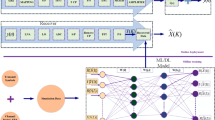Abstract
In this paper, we investigate channel frequency response (CFR) matrix and interference-plus-noise covariance matrix (ICM) estimation in multiple-input multiple-output (MIMO) and orthogonal frequency division multiplexing (OFDM) systems to suppress co-channel interference at the receiver side. We employ least square criterion to perform the initial CFR estimation. Then we estimate the autocorrelation function of interference-plus-noise in the time domain, instead of estimating the ICM in the frequency domain directly. The autocorrelation function estimation has two steps. Firstly, we present the inherent relationship between the expectation of the sample autocorrelation function of the residual (SAFR) and the true autocorrelation function, which is actually a linear transformation. Based on this, we propose a compensating method. This compensation brings significant performance gains when the pilot OFDM symbol number is small. Secondly, since the compensated SAFR cannot be guaranteed to be an autocorrelation sequence (ACS), which will make the obtained ICM loss the positive semidefinite property, we utilize semidefinite programming (SDP) to find an ACS that is the nearest to the compensated SAFR. The SDP is solved in its dual form, which yields a significant reduced complexity. Finally the estimated ICM is reutilized to revise the CFR estimation. The estimated CFR and ICM show excellent interference suppression performances when being applied in an interference rejection combining receiver.
Similar content being viewed by others
References
IEEE 802.16 Working Group. IEEE standard for local and metropolitan area networks part 16: a broadband wirless access systems. IEEE Std, 2004
3rd Generation Partnership Project (3GPP). Technical specification group radio access network; Evolved universal terrestrial radio access (EUTRA); Physical channels and modulation. 3GP-TS-36.211 v8.0.0
Fang K, Auer G. Iterative OFDM receiver with combined interference suppression and cancellation. In: Proceedings of IEEE Symposium on Personal Indoor and Mobile Radio Communications, Toronto, 2011. 1412–1416
Ohwatari Y, Miki N, Sagae Y, et al. Investigation on advanced receiver employing interference rejection combining for space-frequency block code transmit diversity in LTE-Advanced downlink. In: Proceedings of IEEE Symposium on Personal Indoor and Mobile Radio Communications, Sydney, 2012. 2414–2420
Lampinen M, Del Carpio F, Kuosmanen T, et al. System-level modeling and evaluation of interference suppression receivers in LTE system. In: Proceedings of IEEE Vehicular Technology Conference, Yokohama, 2012. 1–5
Léost Y, Abdi M, Richter R, et al. Interference rejection combining in LTE networks. Bell Labs Tech J, 2012, 17: 25–49
Li Y, Seshadri N, Ariyavisitakul S. Channel estimation for OFDM systems with transmitter diversity in mobile wireless channels. IEEE J Sel Area Comm, 1999, 17: 461–471
Li Y. Simplified channel estimation for OFDM systems with multiple transmit antennas. IEEE Trans Wirel Commun, 2002, 1: 67–75
Li Y, Winters J H, Sollenberger N R. MIMO-OFDM for wireless communications: signal detection with enhanced channel estimation. IEEE Trans Wirel Commun, 2002, 50: 1471–1477
Larsson E G. Semi-structured interference suppression for orthogonal frequency division multiplexing. In: Proceedings of IEEE Symposium on Signal Processing and Information Technology, Washington, 2003. 435–438
Jeremic A, Thomas T A, Nehorai A. OFDM channel estimation in the presence of interference. IEEE Trans Signal Proces, 2004, 52: 3429–3439
Maltsev A, Maslennikov R, Khoryaev A. Comparative analysis of spatial covariance matrix estimation methods in OFDM communication systems. In: Proceedings of IEEE Symposium on Signal Processing and Information Technology, Vancouver, 2006. 551–555
Li Q, Zhu J, Li Q, et al. Efficient spatial covariance estimation for asynchronous co-channel interference suppression in MIMO-OFDM systems. IEEE Trans Wirel Commun, 2008, 7: 4849–4853
Raghavendra M R, Juntti M, Myllyla M. Co-channel interference mitigation for 3G LTE MIMO-OFDM systems. In: Proceedings of IEEE International Conference on Communications, Dresden, 2009. 1–5
Han J S, Jang J H, Choi H J, et al. Enhanced spatial covariance matrix estimation for asynchronous inter-cell interference mitigation in MIMO-OFDMA system. In: Proceedings of IEEE Vehicular Technology Conference, Barcelona, 2009. 1–5
Narasimhan R, Cheng S. Channel estimation and co-channel interference rejection for LTE-Advanced MIMO uplink. In: Proceedings of IEEE Wireless Communications and Networking Conference, Shanghai, 2012. 416–420
Bishop C M, Nasser M N. Pattern Recognition and Machine Learning. New York: Springer, 2006
Löfberg J. YALMIP: a toolbox for modeling and optimization in MATLAB. In: Proceedings of IEEE Conference on Computer-Aided Control System Design, Taipei, 2004. 284–289
Dumitrescu B, Tabus I, Stoica P. On the parameterization of positive real sequences and MA parameter estimation. IEEE Trans Signal Proces, 2001, 49: 2630–2639
Bjornson E, Ottersten B. A framework for training-based estimation in arbitrarily correlated rician MIMO channels with rician disturbance. IEEE Trans Signal Proces, 2010, 58: 1807–1820
Kay S M. Fundamentals of Statistical Signal Processing. NJ: Prentice-Hall, 1993
Wang D, Jiang Y, Hua J, et al. Low complexity soft decision equalization for block transmission systems. In: Proceedings of IEEE International Conference on Communications, 2005. 2372–2376
Chu D. Polyphase codes with good periodic correlation properties. IEEE Trans Inform Theory, 1972, 18: 531–532
Hannan E J. Multiple Time Series. New York: Wiley, 1970
Stoica P, Moses R. Spectral Analysis of Signals. NJ: Prentice-Hall, 2005
Stoica P, Xu L, Li J, et al. Optimal correction of an indefinite estimated MA spectral density matrix. Elsevier Stat Probab Lett, 2007, 77: 973–980
Boyd S P, Vandenberghe L. Convex Optimization. Cambridge: Cambridge University Press, 2004
Author information
Authors and Affiliations
Corresponding author
Rights and permissions
About this article
Cite this article
Meng, X., Jiang, B. & Gao, X. Efficient co-channel interference suppression in MIMO-OFDM systems. Sci. China Inf. Sci. 58, 1–15 (2015). https://doi.org/10.1007/s11432-014-5099-3
Received:
Accepted:
Published:
Issue Date:
DOI: https://doi.org/10.1007/s11432-014-5099-3




